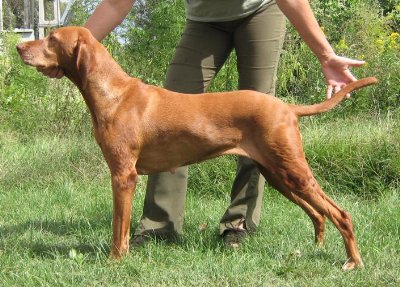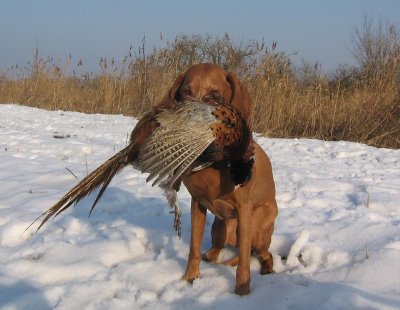
Welcome to the Bereki Kennel's Website!
 Berek  Paff  Paff and friends  Gitár  Csatárkai Suba Sába  Field Trial Europe Cup winner team  Csatárkai Suba Sába 11 years old |
I have been interested in animals since my childhood, I even choose my profession according to this. After finishing the university I moved from Budapest to Balatonfenyves, where I became an agronomist and I worked in horse breeding - the love of my life - and cattle breeding. It was also possible to keep dogs the way I liked.When I was a child, our first family dog was a dachshund. In Balatonfenyves, I had a Hungarian vizsla in 1985. Paff was a love-child, a smooth-haired and wire-haired cross, so I could not breed him, but I became a fan of this breed. There was high-quality gamekeeping in the state farm where I worked, so I decided to try his ability at a winter pheasant hunt. He new his duty without any previous practicing, he already waited for the birds to apport at the feet of the German hunter at the second offshoot. Vizslas are very playful and kind to strangers, so somebody took him without my permission when he was 2 years old... I was inconsolable for a long time.During the years I had many adopted dogs, so there was a real herd at my house sometimes. I got Hubertus Gitár, the founder of the kennel from a very good breeder in 1989. The first puppies were born in 1990.She had puppies 4 times, bred every second year. Even though I had no breeding conception at that time, the quality of her progeny was quite steady. She looked very young even at the age of 8. She was not a trained hunting dog, yet she escaped to the pheasants one time and never came back...When I took the 7 weeks old Sába from her breeder, Bernáth Katalin in 1997, I already had a clear idea about vizsla breeding. Primarily I promised to take more care for her, as I lost many dogs in ways later seemed to be possible to have escaped (car accident, rat poison, etc.). That's why Csatárkai Dbecame a home-pet, even though I had a garden. As she originated from working lines, I decided to train her. I wanted to try everything the vizsla, as an all-round hunting dog might be suitable for. Later I had to admit that reading the order books is rather different from making the dog understand its duties on the exams and competitions. As a first-dog-trainer I made a lot of mistakes, but Sába corrected them many times. In fact she taught me the language of the hunting dogs. During the years she made my dreams come true: not only did she receive many show medals and championships, but we successfully competed in working trials, too. As an all-round hunting dog, she won first prizes at water-field competitions as well as all-round vizsla trials, but she was also doing well in special trials, even though the blood-track competitions require different talents than let's say the special Field Trials.
A great experience was to be member of the Field Trial Europe Cup winner team in 2001. |
It was much later that I met the Mudi breed. I prefer the gaudy colour. I did not know much about the temperament of the Mudis when I bought Dunamenti Nyájas Csincsere of Sacaházi line, for the request of my son. Her name is now Becses. This original Hungarian sheepdog is very different from the Vizsla. I had to learn that this breed is not a dog of fashion, but rather a special breed for shepherd's work. It feels well in its natural agent, near the animals. It was first time at her one-year-olds' shepherd's trial that his bitch saw sheep, yet one could not only see her shepherding instinct in the first moment, but she recognized the escaping sheep at once and ran to close it in.When she was 2 years old, we regularly went to shepherd cows in the Berek. The cowmen liked her, as there were not too many good sheepdogs around. At the age of three, she was competing successfully at the official sheepdog competitions, led by my son. As a result of her good instinct, she helped her young and not too experienced master to the prize of the National Shepherd Champion. She has had two litters by now, and I am always amazed to see the stable shepherd's instinct of the young Mudis. Fortunately, more of her puppies are still in my sight, and they are active working dogs.Breeding the traditional Hungarian dogs is a big responsibility, as the excellent characters of these breeds must be maintained and shown to the world, considering not only their outlooks, but also their intelligence and instincts, that show the selection work of more centuries. The development of the breeds derives from Hungary's historical, economical and natural facilities, and its hunting and breeding culture. I am lucky to live in a place where I can see these two wonderful dog breeds in work day by day.Ms. Mónika Csíkvári |
 National Shepherd Championship - final    |